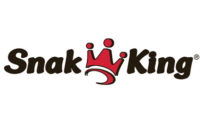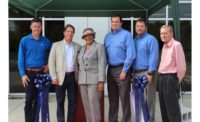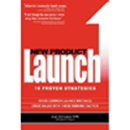![]()
The King’s New Castle
King’s Hawaiian’s new plant in Torrance, Calif., is so automated that it can produce up to four times more product than its two previous plants combined with greaterconsistency, efficiency and flexibility.
by Dan Malovany
Then King’s Hawaiian decided to replace its aging bakeries on Western and Normandie avenues in Torrance, Calif., Mark Taira thought about moving outside of the state. Sure, Southern California is a great place to live. There’s the warm weather, the refreshing ocean, hot beaches, cool surfers and swaying palm trees. In many ways, it’s the closest thing to Hawaii on the U.S. mainland.
But for business, California doesn’t have the “hang loose” attitude. Hardly. Difficult? Definitely. There are environmental regulations, earthquake requirements, employment costs, soaring energy prices and expensive real estate, just to name a few. Yes, moving out of state crossed Taira’s mind more than once.
“Nevada was very tempting,” says the chief executive officer of King’s Hawaiian Bakery West Inc. “We really looked at going out of state, but there is still a lot of family involved in our business. One of the things that keeps our family close is that we’re all in this together, and nobody wanted to move out of state. For the family, being together is extremely important. It was more based upon family values.”
After deciding to remain in Torrance, the next priority became automating the production process to reduce overhead, minimize labor, improve production consistency, enhance product quality and allow the company to produce a wide variety of new products that it hadn’t been able to do since it reached capacity at its smaller plants on Normandie and Western avenues.
“When we were designing the plant three years ago, getting everything as automated as possible was critical,” Taira recalls. “We are going to produce three or four times the amount of product that we produce today with about the same number of employees. We’re able to do that with automation.”
The 151,000-sq.-ft. plant houses two lines, and Dino Sheardown, operations manager, notes that there is plenty of room to add a yet-to-be determined third line that will produce a totally new product.
Additionally, the old plants ran 24 hours-a-day, seven days a week. At the new plant, Sheardown expects two shifts will run the roll line five days a week with one shift on the bread line initially. When other shifts are added in, it’s easy to calculate how the new plant can produce three and even four times the volume of the older facilities, and there are other benefits as well.
“We’re now going to be able to tie our manufacturing back to sales, which we weren’t able to do in the past,” Taira says. “That will expedite getting orders out and help us manage inventory better.”
The new operation has robotic pan handling, robotic palletizing, a sophisticated warehouse management system and computer controls monitoring every phase of production. When the old facilities were built, they were state-of-the-art for their time, but some 20-plus years ago, computers were still in their infancy and rarely seen in the baking industry.
“One of the most wonderful things from an operations standpoint is that we’re able to get all of this feedback from your equipment,” Taira says. “If something goes down, it tells you what’s wrong. The computers tell you when to maintain your equipment. They tell you what product you are making and what temperatures — everything that you need to know to run your operation efficiently. That’s one of the biggest accomplishments on the equipment side of the industry.”
Recently, an inspector from the American Institute of Baking toured the facility and called it a “Taj Mahal” because he was so impressed with the building and its operation, Sheardown says.
In March, King’s Hawaiian started up the roll line and shut down its Normandie plant. By June, the bread line should be fully up and operating, allowing the company to shut down its Western plant. By then, the new headquarters, which is now at a third location, will be complete as well.
“It will be really nice,” Sheardown says. “It will be like the good ol’ days when we were all at the same facility in Western.”
Yes, Taira says, it will be like one happy family all together again.
“Because we were in three places, we didn’t get together as often and work on projects,” he says. “Being in one building, it’s easier for us to work together as a team. I grew up in the bakery, and because my office is separate from the manufacturing plants, I can’t even walk to my door and get my own bread. I have to drive to my plant to get it. It will be really nice just to walk out and get a fresh loaf of bread to eat.”
Ratcheting it Up The new plant, which is strategically located at the Harbor Gateway area of Los Angeles near the I-405 and I-110 expressways, is not only designed to increase production quality and capacity, but also to address a number of sanitation, maintenance and food safety issues. For example, the granulated sugar and flour silos are enclosed inside the bakery to enhance sanitation and protect the systems against the elements.
The silos, which vacuum-convey ingredients to continuous mixers, have extra supports to protect them against earthquakes. Inside the bakery, minor and micro ingredients are stored in a new rack system, which can be easily picked and placed for use. Nearby, there’s a “component room” with a material handling system that can dispense up to 25 different minor and micro dry ingredients. As a food safety measure, every bagged ingredient is bar-coded and scanned before it’s dumped, and then tracked throughout the production process to provide a continuous loop of information that continuously tracks production, especially if an issue arises.
“After we scan the bag, we then scan the dump system and scan the pie or destination for the ingredient,” Sheardown says. “We have a complete tracking of the ingredients from when they’re used to when the products are processed.”
At the front of the operation, there is also a separate walk-in cooler set at 40°F for ingredients that need to be refrigerated. The bakery uses a system, similar to a dumb waiter or lift, to bring up butter and other ingredients that need to be manually added to the process.
King’s Hawaiian built a commissary that can serve as an R&D center, work like a pilot plant, produce short runs of specialty products for test market or operate like a retail bakery within a bakery to supply its two restaurants.
King’s Hawaiian requested that the mixing process and line speeds remain proprietary. After mixing on the roll line, which makes sandwich rolls and dinner rolls, chunks of dough travel down two separate conveyors into two, six-pocket piston dividers. During the production of four-pack dinner rolls, six pieces enter a double indexer, which lines up 12 pieces that drop into the pan at one time. Each roll pan can make 18 four packs at a time.
For 12 packs, an automatic tray former assembles bakable trays, which are conveyed to a robotic pick-and-place system that puts the trays into a carrier pan, Sheardown says. King’s Hawaiian uses the carrier pan to align the trays for indexing and filling with dough pieces.
Robotic Pan Handling
On the dual robotic pan handling system, a gripper rides along parallel rails or tracks and picks up a row of 12 pans at a time and places it on a feeding conveyor. After setting the pans down, a photo eye counts the pans heading toward the divider. When photo sensor indicates the feed conveyor is clear, the system calls for the gripper to get more pans.
Likewise, when the run is complete, the pans enter the feeding conveyor, and the gripper picks and places the pans in the appropriate stack.
The continuous proofers on both lines are mirror images of one another. Inside the proofers are stairs leading to a two-tier platform that’s designed to easily undo any jams and simplify cleaning and maintenance. On the roll line, 14 pans bake at one time in the 70-ft., direct-fired oven. After depanning, the product loops back to the oven’s entrance and around and into a central enclosed cooler. Because it’s enclosed, the system minimizes mold and other issues, Sheardown says.
The Bakery’s 405 Interchange
After cooling, the breads and rolls leave from separate exits and enter what can best be described as a complex maze of switches and conveyors. Sheardown likes to call it the “405 Interchange” after the infamous spaghetti bowl of lanes and roads nearby. Here, switches can divert products to a number of different packaging machines below.
The bakery also has two 12-pack dinner roll packaging machines that can also bag King’s Hawaiian unsliced rounds. There’s one slicer/bagger for only sandwich rolls and another for the new sliced breads. In all, the plant has eight packaging stations. Because the round breads are on metal tins, King’s Hawaiian uses an X-ray machine instead of metal detectors that are on the other packaging systems.
At each packaging station, operators manually assemble cases. Each station also has a pneumatic packaging system where operators can use a foot pedal to raise or lower the cases. After manual loading, the filled cases slide under the conveyor carrying the products to a tape sealer and bar coder, which stencils on production information and lot number date and time.
Finally, the cases pass by a bar-code verifier, which ensures that the case can be tracked by the sophisticated warehouse management system. If the code is read and accepted, the case full of baked goods travels up an incline conveyor to the warehouse for palletizing and freezing. If not, the case is diverted until a legible code is put on the case.
In the distribution area, all drivers must first visit the check in and check out room. The bakery has a separate dock for all packaging materials. There is also an ingredient check-in area and a dedicated dock for local fresh delivery. King’s Hawaiian has three 48-ft. trailers that deliver product in Southern California as far away as Riverside, Calif.
In the warehouse area, a robot palletizer feeds the central holding freezer, which is set at –20°F. Inside the freezer, an automatic storage and retrieval system (ASRS) places the pallets in one of 600 slots.
Because the freezer has a captive pallet system, 14 slots are used as storage for the “slave” boards that are used as the platforms for building the pallets of product. Each pallet contains a radio frequency chip to help the ASRS identify where the products are stored.
Next to the palletizer outside the freezer is a depalletizer. Here, using the warehouse management system, the system takes cases off the pallets and onto a conveyor leading to the refrigerated docking room. It can custom-match almost any order by picking either full or partial pallets. The cases are loaded onto a conveyor that leads down to the cooler dock. Typically, the bakery fills 10 to 15 trucks a day with product out of four docks in the loading area.
Although the bakery will greatly expand production using the same number of employees, King’s Hawaiian has had to hire five new maintenance workers and an engineer who has been specifically trained on the highly automated, digitalized systems. The company also has to retrain its current employees as they move from a relatively low-tech environment to a high-tech one.
“When you consolidate two plant into one, there’s always a learning curve,” Sheardown says.
For Taira, getting the new plant up and running has been one of the company’s crowning achievements over the last few years.






